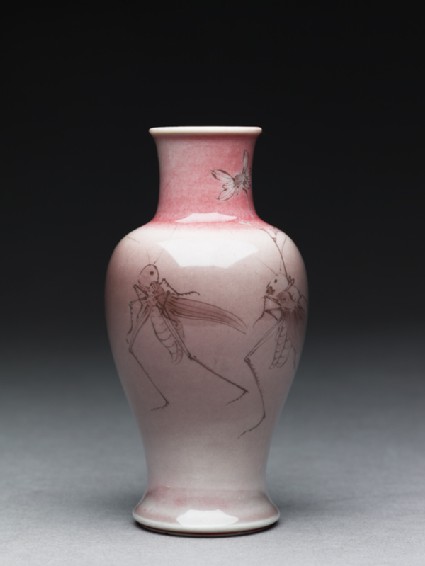Browse: 2213 objects
- Reference URL
Actions
Baluster vase with a procession of insects
-
Details
- Associated place
-
Asia › Japan › Honshū › Kantō › Kanagawa prefecture › Yokohama › Ota › Makuzu kiln-site (place of creation)
- Date
- c. 1895
- Artist/maker
-
Makuzu kiln (1871 - 1959) (potter)
- Material and technique
- porcelain, thrown, with painting in copper-red under a 'peach-bloom' glaze
- Dimensions
-
12.4 cm (height)
6.3 cm (diameter)
- Material index
- Technique index
- Object type index
-
container › vessel › vase › baluster vase
- No. of items
- 1
- Credit line
- Presented by Sir Herbert Ingram, 1956.
- Accession no.
- EA1956.667
-
Further reading
Impey, Oliver, and Joyce Seaman, Japanese Decorative Arts of the Meiji Period 1868-1912, Ashmolean Handbooks (Oxford: Ashmolean Museum, 2005), no. 6 on p. 20, p. 8, illus. pp. 20-21
Glossary (2)
glaze, porcelain
-
glaze
Vitreous coating applied to the surface of a ceramic to make it impermeable or for decorative effect.
-
porcelain
Ceramic material composed of kaolin, quartz, and feldspar which is fired to a temperature of c.1350-1400⁰c. The resulting ceramic is vitreous, translucent, and white in colour.
Location
Objects are sometimes moved to a different location. Our object location data is usually updated on a monthly basis. Contact the Jameel Study Centre if you are planning to visit the museum to see a particular object on display, or would like to arrange an appointment to see an object in our reserve collections.
Collection trails
Galleries
Publications online
-

Japanese Decorative Arts of the Meiji Period
Small baluster-shaped vase with wide neck and slightly everted rim. Decorated under a pale uneven peach-bloom glaze with a procession of three insects holding various flowers. Seal-mark in underglaze blue on the base: Makuzu Kōzan sei.
Kōzan made several shapes and sizes of vases with a peach-bloom glaze decorated with underglaze copper-red drawings of processions of insects carrying flowers as if they were banners. These, caricatures of Edo period daimyō processions, derive from paintings by artists such as Nishiyama Hōen (1804-1867), themselves possibly inspired by the twelfth century Chōjō giga handscrolls.
Bought in Japan by Sir Herbert and Lady Ingram in 1908.
© 2013 University of Oxford - Ashmolean Museum









